battery location PONTIAC GRAND PRIX 2007 Owners Manual
[x] Cancel search | Manufacturer: PONTIAC, Model Year: 2007, Model line: GRAND PRIX, Model: PONTIAC GRAND PRIX 2007Pages: 526, PDF Size: 2.92 MB
Page 86 of 526
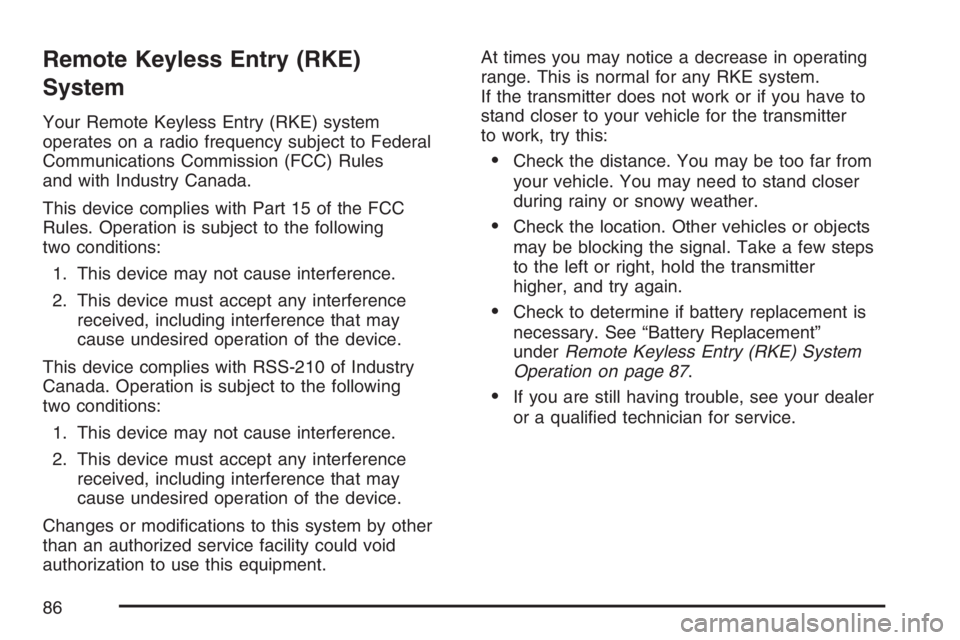
Remote Keyless Entry (RKE)
System
Your Remote Keyless Entry (RKE) system
operates on a radio frequency subject to Federal
Communications Commission (FCC) Rules
and with Industry Canada.
This device complies with Part 15 of the FCC
Rules. Operation is subject to the following
two conditions:
1. This device may not cause interference.
2. This device must accept any interference
received, including interference that may
cause undesired operation of the device.
This device complies with RSS-210 of Industry
Canada. Operation is subject to the following
two conditions:
1. This device may not cause interference.
2. This device must accept any interference
received, including interference that may
cause undesired operation of the device.
Changes or modi�cations to this system by other
than an authorized service facility could void
authorization to use this equipment.At times you may notice a decrease in operating
range. This is normal for any RKE system.
If the transmitter does not work or if you have to
stand closer to your vehicle for the transmitter
to work, try this:
Check the distance. You may be too far from
your vehicle. You may need to stand closer
during rainy or snowy weather.
Check the location. Other vehicles or objects
may be blocking the signal. Take a few steps
to the left or right, hold the transmitter
higher, and try again.
Check to determine if battery replacement is
necessary. See “Battery Replacement”
underRemote Keyless Entry (RKE) System
Operation on page 87.
If you are still having trouble, see your dealer
or a quali�ed technician for service.
86
Page 347 of 526
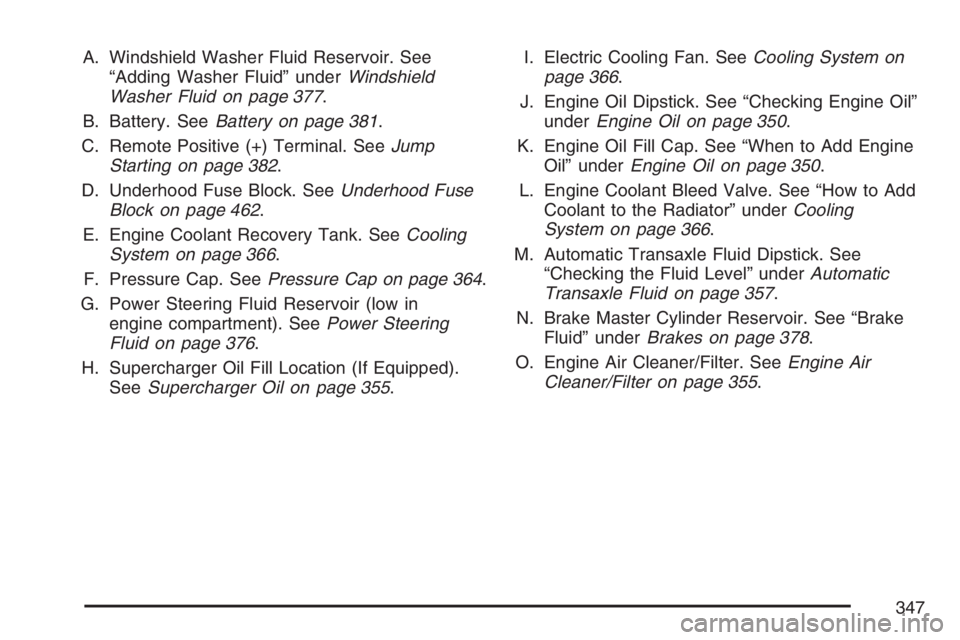
A. Windshield Washer Fluid Reservoir. See
“Adding Washer Fluid” underWindshield
Washer Fluid on page 377.
B. Battery. SeeBattery on page 381.
C. Remote Positive (+) Terminal. SeeJump
Starting on page 382.
D. Underhood Fuse Block. SeeUnderhood Fuse
Block on page 462.
E. Engine Coolant Recovery Tank. SeeCooling
System on page 366.
F. Pressure Cap. SeePressure Cap on page 364.
G. Power Steering Fluid Reservoir (low in
engine compartment). SeePower Steering
Fluid on page 376.
H. Supercharger Oil Fill Location (If Equipped).
SeeSupercharger Oil on page 355.I. Electric Cooling Fan. SeeCooling System on
page 366.
J. Engine Oil Dipstick. See “Checking Engine Oil”
underEngine Oil on page 350.
K. Engine Oil Fill Cap. See “When to Add Engine
Oil” underEngine Oil on page 350.
L. Engine Coolant Bleed Valve. See “How to Add
Coolant to the Radiator” underCooling
System on page 366.
M. Automatic Transaxle Fluid Dipstick. See
“Checking the Fluid Level” underAutomatic
Transaxle Fluid on page 357.
N. Brake Master Cylinder Reservoir. See “Brake
Fluid” underBrakes on page 378.
O. Engine Air Cleaner/Filter. SeeEngine Air
Cleaner/Filter on page 355.
347
Page 381 of 526

When you replace parts of your braking
system — for example, when your brake linings
wear down and you need new ones put in — be
sure you get new approved GM replacement parts.
If you do not, your brakes may no longer work
properly. For example, if someone puts in brake
linings that are wrong for your vehicle, the
balance between your front and rear brakes can
change — for the worse. The braking performance
you have come to expect can change in many other
ways if someone puts in the wrong replacement
brake parts.
Battery
Your vehicle has a maintenance free battery.
When it is time for a new battery, get one that has
the replacement number shown on the original
battery’s label. We recommend an ACDelco
®
replacement battery. SeeEngine Compartment
Overview on page 346for battery location.
Warning:Battery posts, terminals, and related
accessories contain lead and lead compounds,
chemicals known to the State of California
to cause cancer and reproductive harm. Wash
hands after handling.If the battery has a very low charge or is dead,
you may not be able to remove the ignition
key from the ignition switch or shift out of
PARK (P). Refer toShifting Out of Park (P) on
page 117.
Vehicle Storage
If you are not going to drive your vehicle for
25 days or more, remove the black, negative (−)
cable from the battery. This will help keep the
battery from running down.
{CAUTION:
Batteries have acid that can burn you and
gas that can explode. You can be badly
hurt if you are not careful. SeeJump
Starting on page 382for tips on working
around a battery without getting hurt.
381
Page 383 of 526
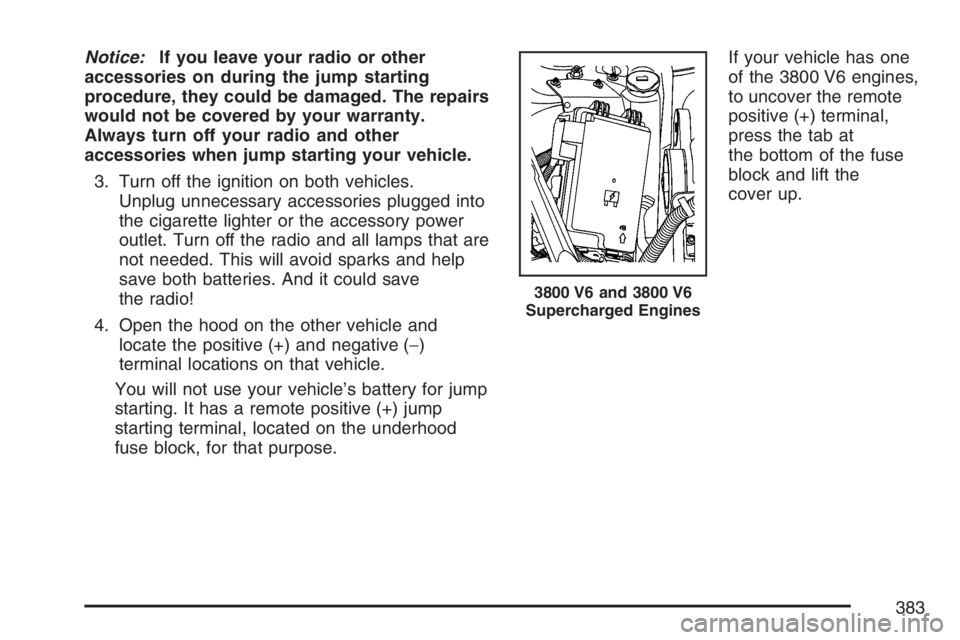
Notice:If you leave your radio or other
accessories on during the jump starting
procedure, they could be damaged. The repairs
would not be covered by your warranty.
Always turn off your radio and other
accessories when jump starting your vehicle.
3. Turn off the ignition on both vehicles.
Unplug unnecessary accessories plugged into
the cigarette lighter or the accessory power
outlet. Turn off the radio and all lamps that are
not needed. This will avoid sparks and help
save both batteries. And it could save
the radio!
4. Open the hood on the other vehicle and
locate the positive (+) and negative (−)
terminal locations on that vehicle.
You will not use your vehicle’s battery for jump
starting. It has a remote positive (+) jump
starting terminal, located on the underhood
fuse block, for that purpose.If your vehicle has one
of the 3800 V6 engines,
to uncover the remote
positive (+) terminal,
press the tab at
the bottom of the fuse
block and lift the
cover up.
3800 V6 and 3800 V6
Supercharged Engines
383
Page 384 of 526
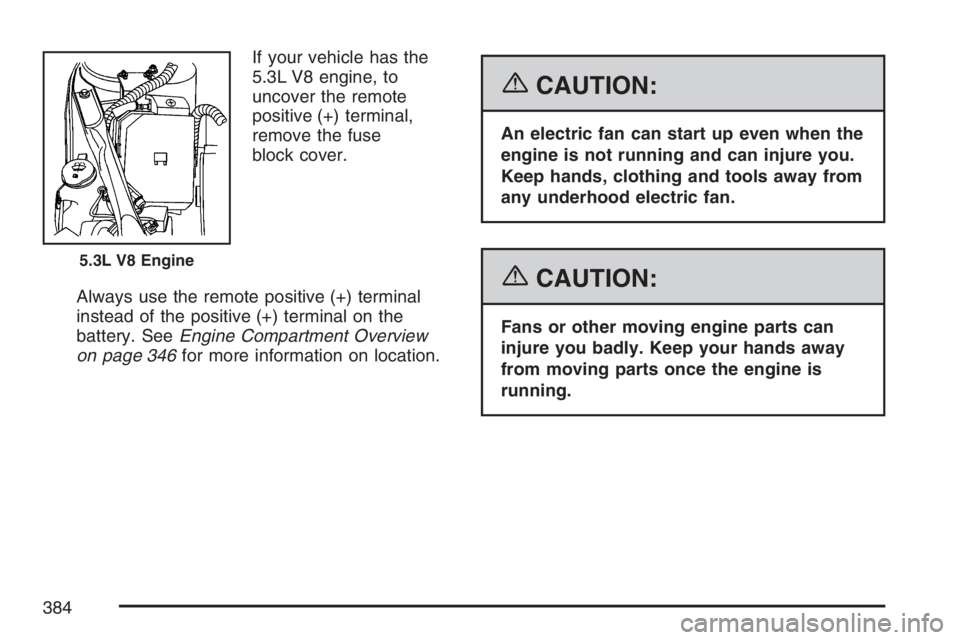
If your vehicle has the
5.3L V8 engine, to
uncover the remote
positive (+) terminal,
remove the fuse
block cover.
Always use the remote positive (+) terminal
instead of the positive (+) terminal on the
battery. SeeEngine Compartment Overview
on page 346for more information on location.
{CAUTION:
An electric fan can start up even when the
engine is not running and can injure you.
Keep hands, clothing and tools away from
any underhood electric fan.
{CAUTION:
Fans or other moving engine parts can
injure you badly. Keep your hands away
from moving parts once the engine is
running.
5.3L V8 Engine
384
Page 386 of 526
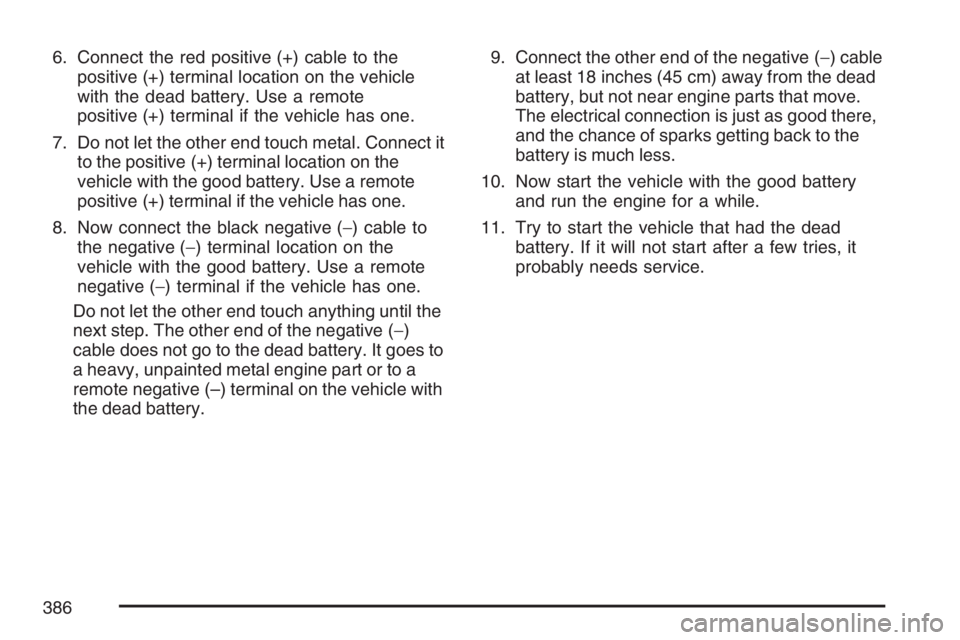
6. Connect the red positive (+) cable to the
positive (+) terminal location on the vehicle
with the dead battery. Use a remote
positive (+) terminal if the vehicle has one.
7. Do not let the other end touch metal. Connect it
to the positive (+) terminal location on the
vehicle with the good battery. Use a remote
positive (+) terminal if the vehicle has one.
8. Now connect the black negative (−) cable to
the negative (−) terminal location on the
vehicle with the good battery. Use a remote
negative (−) terminal if the vehicle has one.
Do not let the other end touch anything until the
next step. The other end of the negative (−)
cable does not go to the dead battery. It goes to
a heavy, unpainted metal engine part or to a
remote negative (–) terminal on the vehicle with
the dead battery.9. Connect the other end of the negative (−) cable
at least 18 inches (45 cm) away from the dead
battery, but not near engine parts that move.
The electrical connection is just as good there,
and the chance of sparks getting back to the
battery is much less.
10. Now start the vehicle with the good battery
and run the engine for a while.
11. Try to start the vehicle that had the dead
battery. If it will not start after a few tries, it
probably needs service.
386